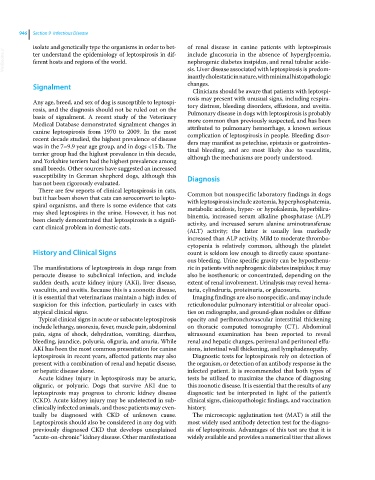Page 1008 - Clinical Small Animal Internal Medicine
P. 1008
946 Section 9 Infectious Disease
isolate and genetically type the organisms in order to bet- of renal disease in canine patients with leptospirosis
VetBooks.ir ter understand the epidemiology of leptospirosis in dif- include glucosuria in the absence of hyperglycemia,
nephrogenic diabetes insipidus, and renal tubular acido-
ferent hosts and regions of the world.
sis. Liver disease associated with leptospirosis is predom-
inantly cholestatic in nature, with minimal histopatho logic
Signalment changes.
Clinicians should be aware that patients with leptospi-
rosis may present with unusual signs, including respira-
Any age, breed, and sex of dog is susceptible to leptospi- tory distress, bleeding disorders, effusions, and uveitis.
rosis, and the diagnosis should not be ruled out on the Pulmonary disease in dogs with leptospirosis is probably
basis of signalment. A recent study of the Veterinary more common than previously suspected, and has been
Medical Database demonstrated signalment changes in attributed to pulmonary hemorrhage, a known serious
canine leptospirosis from 1970 to 2009. In the most complication of leptospirosis in people. Bleeding disor-
recent decade studied, the highest prevalence of disease ders may manifest as petechiae, epistaxis or gastrointes-
was in the 7–9.9 year age group, and in dogs <15 lb. The tinal bleeding, and are most likely due to vasculitis,
terrier group had the highest prevalence in this decade, although the mechanisms are poorly understood.
and Yorkshire terriers had the highest prevalence among
small breeds. Other sources have suggested an increased
susceptibility in German shepherd dogs, although this Diagnosis
has not been rigorously evaluated.
There are few reports of clinical leptospirosis in cats,
but it has been shown that cats can seroconvert to lepto- Common but nonspecific laboratory findings in dogs
with leptospirosis include azotemia, hyperphosphatemia,
spiral organisms, and there is some evidence that cats metabolic acidosis, hyper‐ or hypokalemia, hyperbiliru-
may shed leptospires in the urine. However, it has not binemia, increased serum alkaline phosphatase (ALP)
been clearly demonstrated that leptospirosis is a signifi- activity, and increased serum alanine aminotransferase
cant clinical problem in domestic cats.
(ALT) activity; the latter is usually less markedly
increased than ALP activity. Mild to moderate thrombo-
cytopenia is relatively common, although the platelet
History and Clinical Signs count is seldom low enough to directly cause spontane-
ous bleeding. Urine specific gravity can be hyposthenu-
The manifestations of leptospirosis in dogs range from ric in patients with nephrogenic diabetes insipidus; it may
peracute disease to subclinical infection, and include also be isosthenuric or concentrated, depending on the
sudden death, acute kidney injury (AKI), liver disease, extent of renal involvement. Urinalysis may reveal hema-
vasculitis, and uveitis. Because this is a zoonotic disease, turia, cylindruria, proteinuria, or glucosuria.
it is essential that veterinarians maintain a high index of Imaging findings are also nonspecific, and may include
suspicion for this infection, particularly in cases with reticulonodular pulmonary interstitial or alveolar opaci-
atypical clinical signs. ties on radiographs, and ground‐glass nodules or diffuse
Typical clinical signs in acute or subacute leptospirosis opacity and peribronchovascular interstitial thickening
include lethargy, anorexia, fever, muscle pain, abdominal on thoracic computed tomography (CT). Abdominal
pain, signs of shock, dehydration, vomiting, diarrhea, ultrasound examination has been reported to reveal
bleeding, jaundice, polyuria, oliguria, and anuria. While renal and hepatic changes, perirenal and peritoneal effu-
AKI has been the most common presentation for canine sions, intestinal wall thickening, and lymphadenopathy.
leptospirosis in recent years, affected patients may also Diagnostic tests for leptospirosis rely on detection of
present with a combination of renal and hepatic disease, the organism, or detection of an antibody response in the
or hepatic disease alone. infected patient. It is recommended that both types of
Acute kidney injury in leptospirosis may be anuric, tests be utilized to maximize the chance of diagnosing
oliguric, or polyuric. Dogs that survive AKI due to this zoonotic disease. It is essential that the results of any
leptospirosis may progress to chronic kidney disease diagnostic test be interpreted in light of the patient’s
(CKD). Acute kidney injury may be undetected in sub- clinical signs, clinicopathologic findings, and vaccination
clinically infected animals, and those patients may even- history.
tually be diagnosed with CKD of unknown cause. The microscopic agglutination test (MAT) is still the
Leptospirosis should also be considered in any dog with most widely used antibody detection test for the diagno-
previously diagnosed CKD that develops unexplained sis of leptospirosis. Advantages of this test are that it is
“acute‐on‐chronic” kidney disease. Other manifestations widely available and provides a numerical titer that allows

